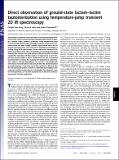Direct observation of ground-state lactam-lactim tautomerization using temperature-jump transient 2D IR spectroscopy
Author(s)
Peng, Chunte Sam; Biaz, Carlos R.; Tokmakoff, Andrei
DownloadPeng-2013-Direct observation.pdf (866.1Kb)
PUBLISHER_POLICY
Publisher Policy
Article is made available in accordance with the publisher's policy and may be subject to US copyright law. Please refer to the publisher's site for terms of use.
Terms of use
Metadata
Show full item recordAbstract
We provide a systematic characterization of the nanosecond ground-state lactam-lactim tautomerization of pyridine derivatives in aqueous solution under ambient conditions using temperature-jump transient 2D IR spectroscopy. Although electronic excited-state tautomerization has been widely studied, experimental work on the ground electronic state, most relevant to chemistry and biology, is lacking. Using 2D IR spectroscopy, lactam and lactim tautomers of 6- chloro-2-pyridoneand2-chloro-4-pyridone are unambiguously identified by their unique cross-peak patterns. Monitoring the correlated exponential relaxation of these signals in response to a laser temperature jump provides a direct measurement of the nanosecond tautomerization kinetics. By studying the temperature, concentration, solvent, and pH dependence, we extract a thermodynamic and kinetic characterization and conclude that the tautomerization proceeds through a two-state concerted mechanism. We find that the intramolecular proton transfer is mediated by bridging water molecules and there action barrier is dictated by the release of a proton from pyridone, as would be expected for an efficient Grothuss-type proton transfer mechanism.
Date issued
2013-05Department
Massachusetts Institute of Technology. Department of ChemistryJournal
Proceedings of the National Academy of Sciences
Publisher
National Academy of Sciences (U.S.)
Citation
Peng, C. S., C. R. Baiz, and A. Tokmakoff. “Direct Observation of Ground-State Lactam-Lactim Tautomerization Using Temperature-Jump Transient 2D IR Spectroscopy.” Proceedings of the National Academy of Sciences 110, no. 23 (June 4, 2013): 9243–9248.
Version: Final published version
ISSN
0027-8424
1091-6490